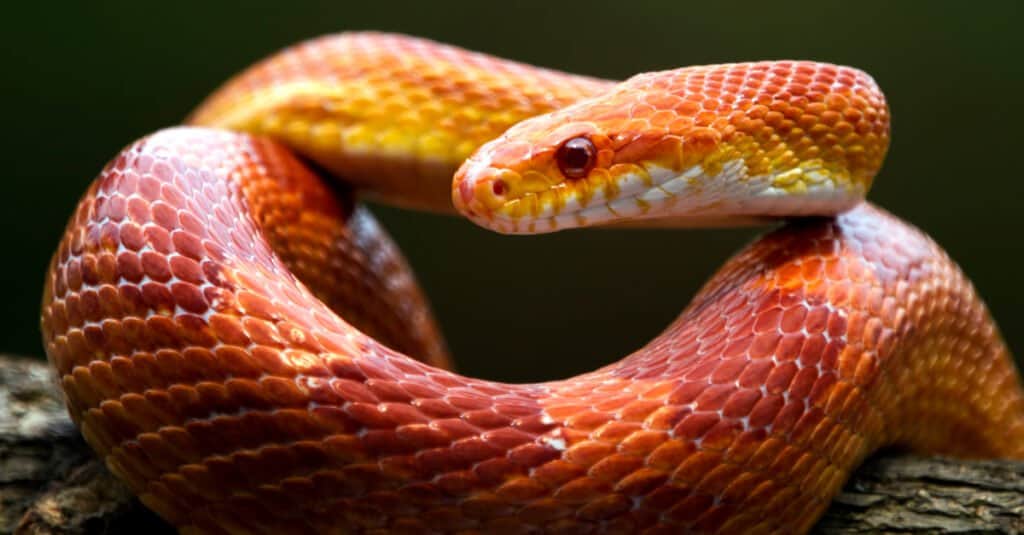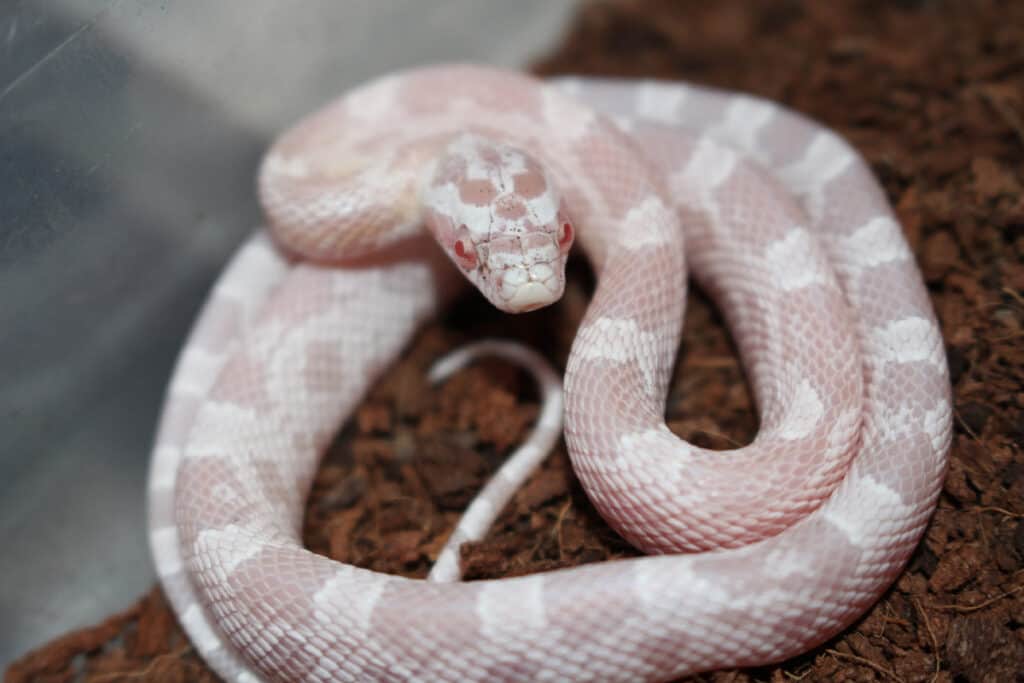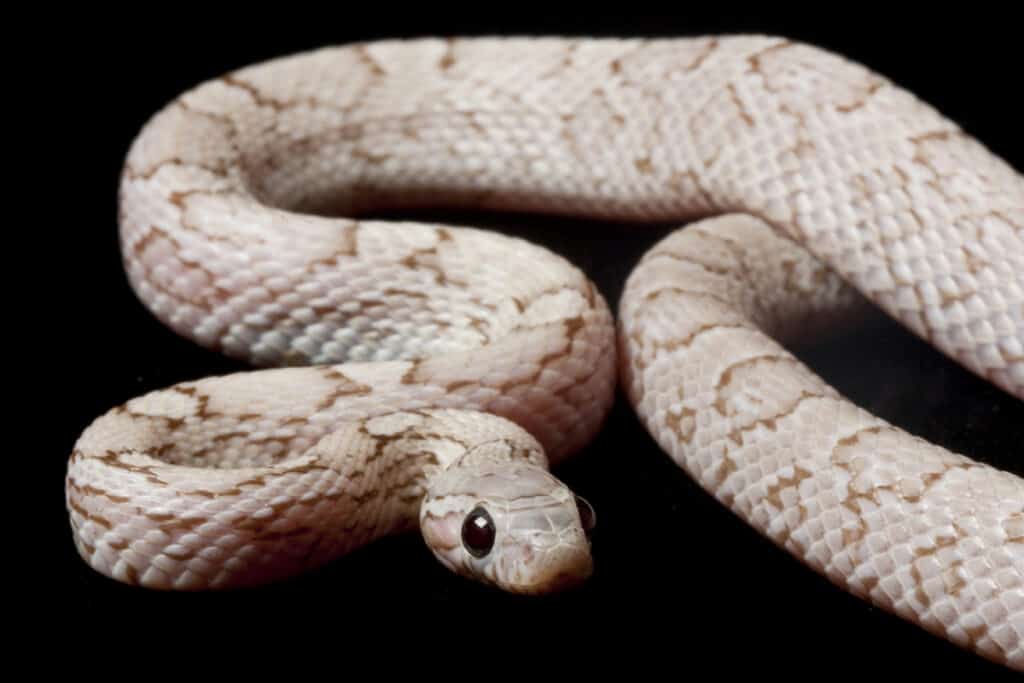There are a lot of amazing facts about corn snakes, but there are a few that are so amazing that they deserve a moment in the spotlight.
These snakes are nonvenomous, and they have the classic characteristics of nonvenomous snakes like round pupils. It’s a fact about corn snakes that they try to flee when cornered and, like a lot of snakes, emit a musk out of their cloaca when threatened.
Corn snakes are a type of rat snake and share a lot of similarities with their neighbors and cousins. They’re considered a New World snake along with all other North American rat snakes, and they might not be as related to their European counterparts as previously thought.
Corn snakes are common in yards and outside storage areas within the range they inhabit. They live in the southeastern United States, and they will bite as a last resort. Their bite poses little threat to humans, and they’re quite easy to handle.
Corn Snakes Are In Australia

Corn snakes have a small presence in Australia.
©Kurit afshen/Shutterstock.com
Even though corn snakes originate in the United States, the underground snake trade and subsequent releases have given them a small presence in Australia. Their population increase has been noted around Sydney.
While they’re not yet fully established as an invasive species, if releases don’t stop, it’s a probability that the corn snake will settle right in. Since most corn snakes thrive in dry climates, Australia is a host to a multitude of new habitats that the corn snake could infest.
Queensland created the Biosecurity Act in 2014 that makes the corn snake a prohibited species. It is illegal to own, breed, sell, release, or see a corn snake without reporting it. One of the main concerns is out-competing local animals and the spread of diseases that don’t yet exist in Australia.
Corn Snakes Can Breed With Other Snake Species
Breeding corn snakes with snakes like Great Plains rat snakes and California kingsnakes are possible. In the pet trade, these are referred to as jungle corn snakes. Turbo corn snakes are babies hatched to a corn snake parent and either a pine or bull snake.
In most other animals, when interbreeding happens, the resultant animal is infertile. Corn snake hybrids can reproduce.
Corn Snakes Are Invasive In The Caribbean
There are newly found populations of corn snakes in the Lesser Antilles, Grand Cayman, the Virgin Islands, and the Bahamas. They were likely stowaways from plants shipped there from southern Florida, where corn snakes have healthy populations.
Corn Snakes Make Great Pets

There are a lot of different corn snake types bred in captivity.
©iStock.com/mynewturtle
While their natural range centers in Florida, corn snakes are popular pets that are often captive bred. They’re good for novice hobbyists because they don’t mind being handled and are relatively calm. Their size and age can pose an issue, though.
Just because a captive-bred corn snake has a peaceful temperament doesn’t mean that its wild counterparts won’t be more upfront about a confrontation due to instinct. Breeding is a process by which undesirable traits are bred out of animals, including behaviors like aggression. These traits, just like their colors, have been specifically bred into pet snakes to make them good pets. That’s why wild animals act so differently than their domesticated counterparts. Even if they bite, it usually doesn’t result in any bleeding and instead feels like a hard pinch. Because of this and their demeanor, they are considered one of the safest pet snakes to keep.
Corn snakes are thin and long, topping out at 6 feet. They can live up to 23 years in captivity, so they’re a commitment. It’s worth noting that they usually grow no older than eight years in the wild due to predation.
You’ll want to make sure that you pick the right enclosure for your corn snake. Generally, adults grow to an average of 5 feet, and your tank will need to accommodate that accordingly. Don’t keep two corn snakes in the same enclosure as they may cannibalize each other.
If you are going to take the plunge and get a corn snake as a pet, make sure that you’re getting your snake from a reputable breeder. Corn snakes carry viruses and parasites like hookworms which can be fatal to your snake.
Corn Snakes Don’t Have Eyelids

Corn snakes don’t have eyelids; they have transparent brille, which is eyeball skin or scale, instead.
©fivespots/Shutterstock.com
Instead of having eyelids, corn snakes have transparent scales over their eyeballs, called brille. They shed their eye scales as the same time they shed the rest of their skin. Their shed cycle takes about five days from start to finish. A proper shed looks like they just slipped out of their old skin.
There Are Over 800 Corn Snake Morphs
The list of corn snake morphs seems to be a mile long, and that’s because a multitude of breeders have dedicated their lives to creating the variations that exist today. One such morph is the scaleless corn snake, which despite its name, still has belly scales so it can get around comfortably.
Corn Snakes Can Get Cancer
It’s possible for a corn snake to develop ovarian cancer as well as other types of diseases. Cancer is scary, and most of us have lives that have been touched by it. Almost all snakes can develop some form of cancer.
There is a documented case of a corn snake that suffered from chondrosarcoma, a type of bone cancer. It ate away at the bone and tissue of the snake.
We associate cancer with mammals, but it’s interesting to realize that there are cancers that can affect almost any type of animal on the planet.
The photo featured at the top of this post is © iStock.com/Tamascsere
Discover the "Monster" Snake 5X Bigger than an Anaconda
Every day A-Z Animals sends out some of the most incredible facts in the world from our free newsletter. Want to discover the 10 most beautiful snakes in the world, a "snake island" where you're never more than 3 feet from danger, or a "monster" snake 5X larger than an anaconda? Then sign up right now and you'll start receiving our daily newsletter absolutely free.
Thank you for reading! Have some feedback for us? Contact the AZ Animals editorial team.







